Press release 2015-02-17 at 9:36
A special focus of Aranda’s monitoring cruise this year was monitoring the major Baltic inflow that occurred in the Baltic Sea around the turn of the year. So far, the inflow has travelled approximately 200 km in the southern part of the Baltic Sea. “The inflow is not yet affecting the condition of the deepest parts of the main basin or the Gulf of Finland”, leader of the cruise Juha Flinkman explains.
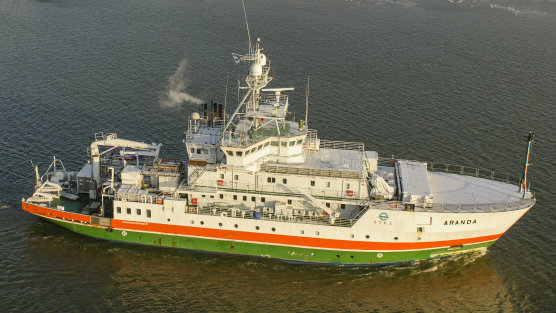
Aranda returned from her winter monitoring cruise to Helsinki on Saturday, 7th February. The cruise covered the Gulf of Finland, including Russian territorial waters, the main Baltic basin, Bornholm and Arkona Basins, the Sea of Åland, the Sea of Bothnia, Kvarken, the Bothnian Bayand the Finnish Archipelago Sea. The research concentrated on water salinity, oxygen and hydrogen sulphide concentrations, and nutrients, with a focus on the forms of primary nutrients nitrogen and phosphorus that are directly useful to algae, i.e. nitrate and phosphate.
High levels of phosphorus in the Gulf of Finland – heavy algal blooms possible in summer
The deep water oxygen content in the Gulf of Finland has improved significantly from last summer and autumn thanks to mixing, but the levels are still lower than in the previous winter. This year, the surface layer contains slightly less nitrate nitrogen than in the winter of 2014, but the opposite is true of phosphate phosphorus. In the Gulf of Finland, the phosphate phosphorus content of the surface layer has increased from last winter due to the phosphate that was released from the seabed and carried to the deep water from the main basin and from the Gulf’s own seabed during last spring, summer and early autumn, and then mixed with the upper water layers due to storms. The nutrient situation will enable heavier algal blooms in the Gulf of Finland over the coming summer, provided that the weather conditions are favourable, i.e. sufficiently warm and calm.
Phosphate in the winters of 2014 and 2015
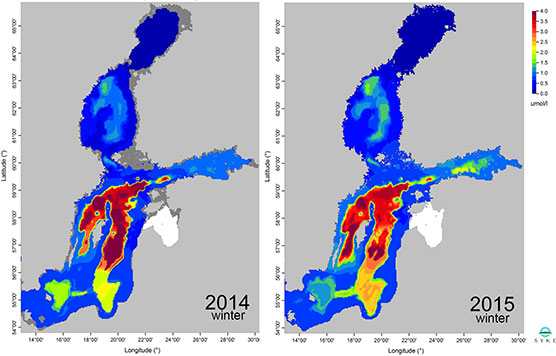
Dissolved inorganic nitrogen at 15 metre depth in the winters of 2014 and 2015
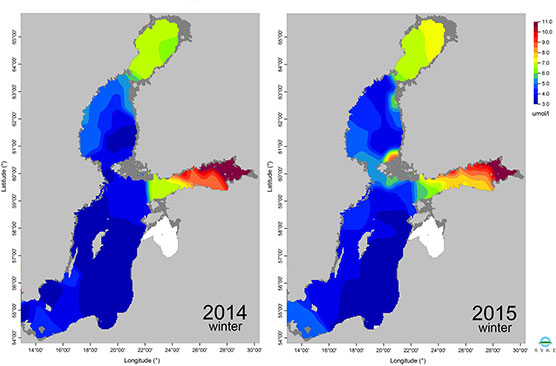
Estimated excess phosphorus in 2015
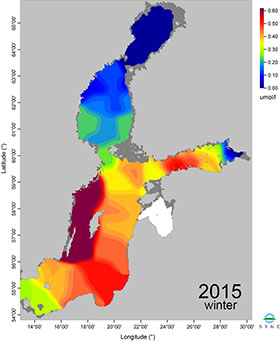
Major Baltic inflow evident in the deeps of the southern Baltic Sea
The major Baltic inflow that arrived from the North Sea at the turn of the year is very clearly evident in the deeps of the Baltic Sea, the basins of Arkona and Bornholm. Water salinity near the seabed is close to 25‰ in parts and over 20‰ in all of the deeps areas, whereas the level last winter was 15‰ or less. The oxygen situation of water near the seabed is now very good, although it worsened for a time over the past year in the Bornholm basin following the lesser Baltic inflows that occurred during the winter and spring of 2014. The inflow that entered the Baltic Sea contained water that has high levels of salt and oxygen.
The halocline (a vertical zone in the water column in which salinity changes rapidly with depth) in the Arkona and Bornholm Basins is currently extremely strong and located at a depth of 30–60 metres. “The inflow is now advancing in the Stolpe Channel towards the Gdansk and the Gotland Deeps. However, it will take approximately six months for the heavy salt water of the inflow to reach the Gotland Deep and other deep sections of the Baltic Sea’s main basin”, Juha Flinkman says.
In filling these deeps, the salt water simultaneously displaces old deep water, which is depleted of oxygen and nutrient-rich. In time, this water will arrive in the northern Baltic Sea and Gulf of Finland, which, unlike the Gulf of Bothnia, does not have a threshold preventing the flow of deep water at its mouth. Upon mixing with the surface layer, the water will cause an increase in the growth of filamentous algae and elevate the risk of blue-green algal blooms. Anoxic, nutrient-rich deep water from the main basin also periodically flows into the Gulf of Finland even without the effects of the major Baltic inflow, as was the case in the spring and summer of 2014.
Due to the prolonged lack of oxygen in the deep water, the phosphate phosphorus reserve of the Baltic Sea’s main basin is high. The concentrations of the main basin’s surface layer are roughly the same as in the winter of 2014. However, on the coast of Sweden, west of the island of Gotland, from the latitudinal position of Stockholm to the southern point of the island of Öland, the phosphate phosphorus content was higher than in the previous winter. In the event of a warm summer, the blue-green algal blooms may be abundant throughout the Baltic Sea’s main basin.
Deep water oxygen condition in the winters 2014 and 2015
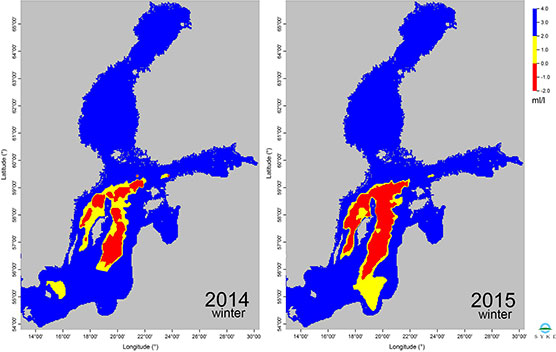
Oxygen profiles 2014 and 2015

Deep water salinity 2014 and 2015
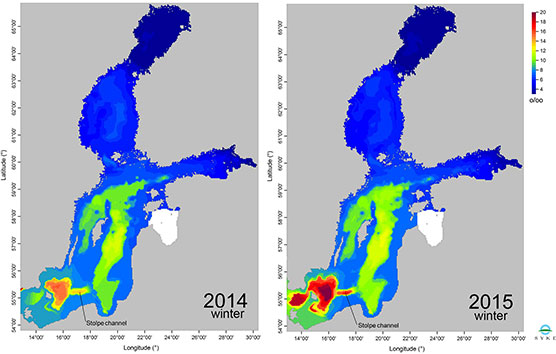
Salinity profiles 2014 and 2015

Increase of phosphorus content extends to the Sea of Åland and the Bothnian Sea
Compared to last winter, the phosphorus content has increased throughout the entire surface layer of the Sea of Åland and the Bothnian Sea, and in their deeps. The oxygen content in the deeps of the Bothnian Sea is approximately the same as in the preceding two winters. The oxygen situation of the deeps has been found to have deteriorated during the 2000s.
Sampling points winter 2015
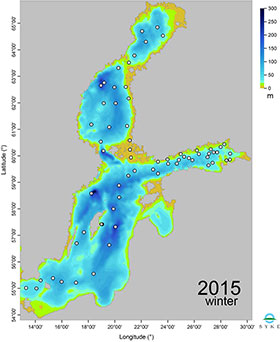
More information
Development Manager Juha Flinkman, SYKE Marine Research Centre
firstname.lastname@ymparisto.fi
Tel. +358 295 251 115
Leading Researcher Kaj Myrberg, SYKE Marine Research Centre
firstname.lastname@ymparisto.fi
Tel. +358 295 251 441